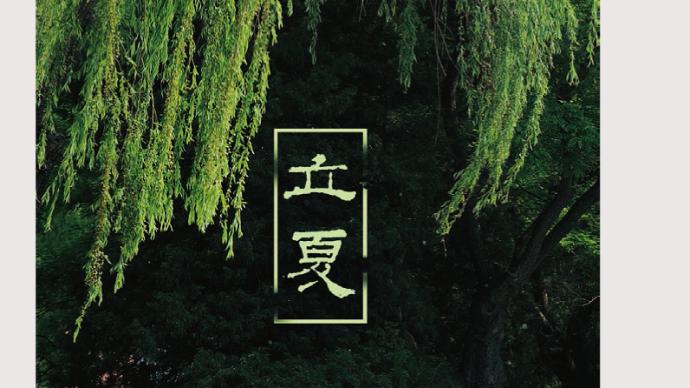
When the sun reaches 45 degrees ecliptic longitude, the Lixia solar term comes, which is the seventh solar term in the twenty-four solar terms and the first solar term in summer. "Dou refers to the southeast, Wei is Lixia, everything has grown up here, so it is called Lixia." "Li, Jianshi, Xia, fake, everything is fake at this time."
This year, May 5th is the beginning of summer, but the astronomical time, the biological time of the earth, and the humanistic time are not strictly consistent. The Chinese often have three months of June, July and August as summer. In climatology, the Chinese scholar Zhang Baokun combined phenological phenomena with agricultural production, and in 1934 put forward the seasonal method of climatology. The climatic (five-day) average temperature decreases steadily to below 10°C as the start of winter, and steadily rises to above 22°C as the start of summer; when the climatic average temperature steadily rises from below 10°C to 10°C, the start of spring; the climatic average temperature starts from 22 When the temperature above ℃ falls steadily to below 22 ℃, it is regarded as the beginning of autumn.
During the beginning of summer, the temperature difference between the north and the south of our country is quite large. Whether it is the beginning of spring or the beginning of summer, the word "Li" may be a kind of hesitation and wandering. Not all the same. This spring is early and the weather is hot. Several torrential rains with a scorching summer atmosphere have already fallen in the south, and the temperature in many areas in the north has once risen to 30 degrees, and it actually feels a bit "scorching hot".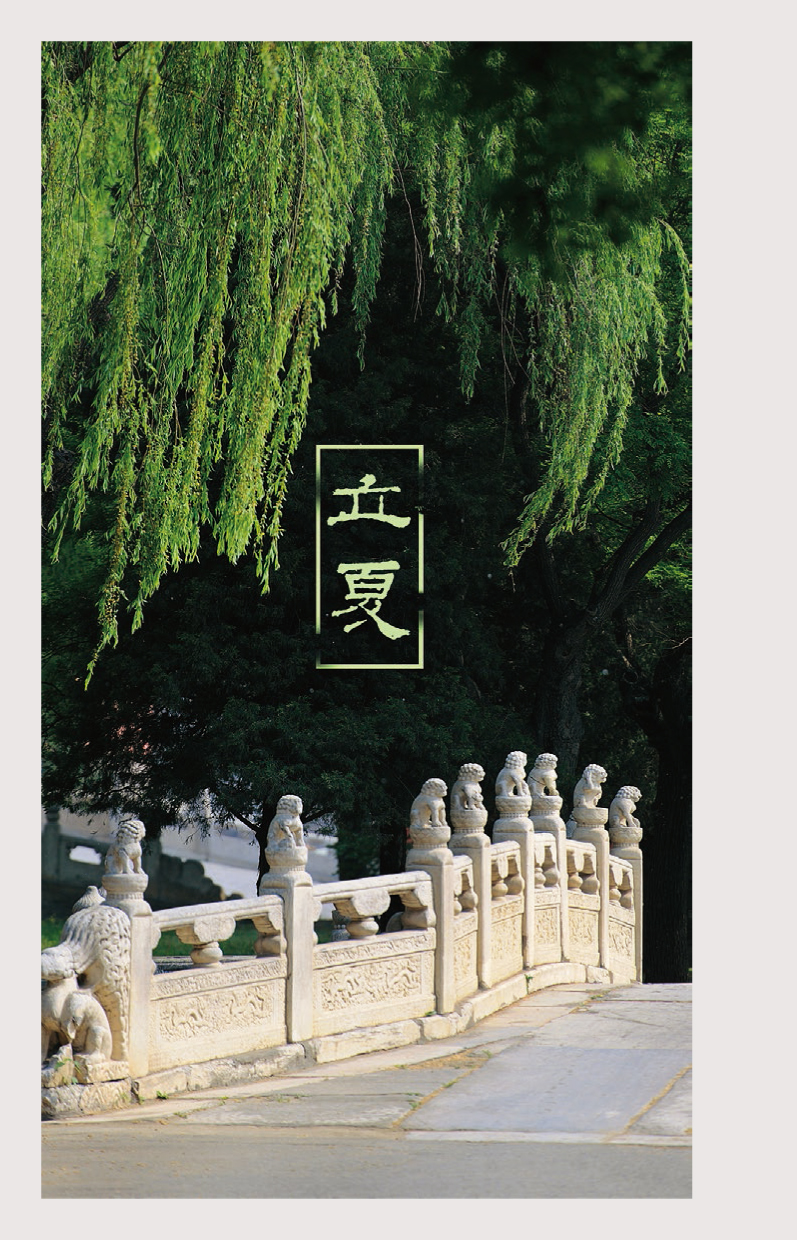 Lixia special offering: peony, peony
Lixia special offering: peony, peony
At the beginning of summer, plum blossoms, magnolias, cherry blossoms, peach blossoms, plum blossoms, lilacs, and begonias have disappeared. The huge flowers of the towering paulownia trees in the north have fallen heavily. The golden and silver honeysuckle is very interesting because of its white-to-yellow flowers. Favored for its dark fragrance, the roses that are suitable for growing in the north begin to charge, and they will bloom brilliantly throughout the summer, making every ordinary street in the north a dream.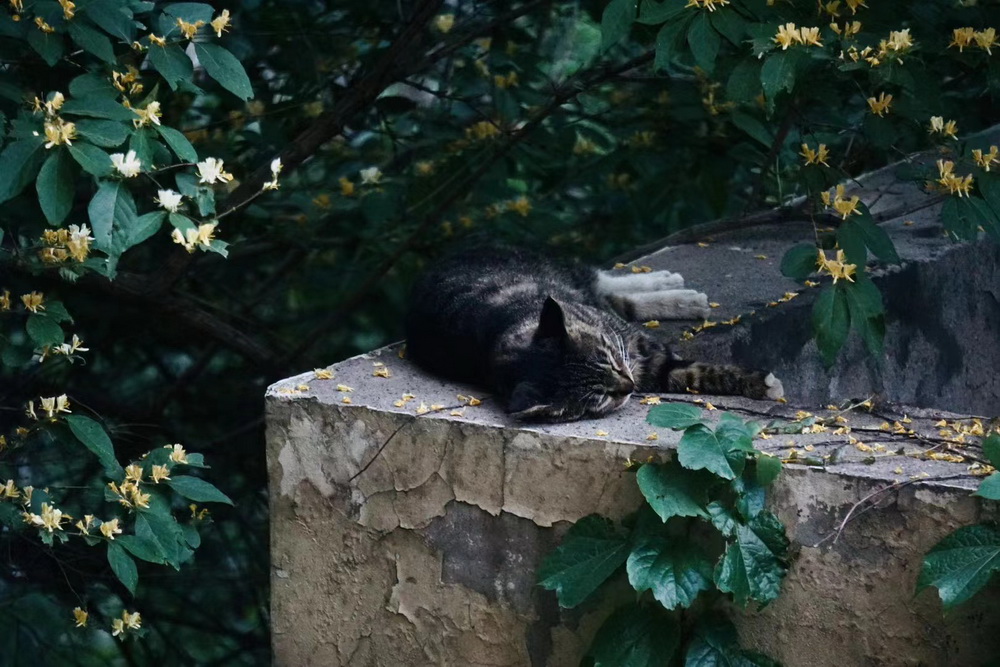
Of course, there are also some new varieties of flowers that attract attention every year. This year's oil painting peony and butterfly peony are the hottest flowers. The flowers of these two kinds of flowers have metallic luster. Oil painting peony, also known as "white phoenix" and "oil peony", is a common single-petal peony variety, which was originally a commercial crop for oil extraction. When it is opened, it is as big as a palm, and its petals are irregularly curled. It has an ancient rhyme of Tang style and has a unique style. It is inevitable that people will lament that it is opened alone and then sent to extract oil. It will inevitably burn the qin and cook the crane.
Celebrating Spring and Beginning of Summer: A Summer of Cultural Significance
Entering into the discussion of the cultural meaning of "Xia", "Xia" means "great and powerful" in both Qiang and Tibetan languages.
The Chinese people in the Spring and Autumn Period said: "Xia is a big country. Therefore, a big country is called Xia." "Shuowen": "Xia is a Chinese person." become the name of a country and culture. China has the greatness of etiquette, so it is called Xia; it has the beauty of clothing and regulations, it is called Hua. Xia has many other names. In "Er Ya", Xia is "Zhu Ming", "Chang Ying", "Nine Summer", "Haotian" and so on. "Han Book of Rites and Music" says: "Zhu Ming is prosperous, and he applies it to all things."
Yu Shicun talked about: The big house is also called Xia, and the tall buildings are the summer house: "I didn't know that Xia was Qiu Xi, but the two east gates could be ruined?" In ancient China, Dashui was also called Xia; Hanshui was once called Xia Shui, Hankou is called Xiakou. Qu Yuan's poem: "Go to your hometown and go far away, follow Jiangxia to exile."
In "The Book of Time", Yu Shicun wrote: The ancestors also had a feeling of cherishing the spring when the beginning of summer came, so they would prepare wine and food for the joy of the beginning of summer, as if they were sending people away. Wu Ou Ting's poem "Lixia" said: "There is no choice but to let the spring go, and let the cherry and bamboo shoots return in the spring."
Beginning of summer to taste new and early adopters is also the right meaning. Broad beans, amaranth, and cucumbers are the "three fresh things in the ground"; cherries, loquats, and apricots are the "three fresh things in trees"; There are also "Lixia eats plum, can make the color beautiful", Lixia eats mulberries, cherries and other food customs. In the Suzhou area, there is a saying that "Lixia sees three new things", and the three new ones are cherries, green plums and wheat, which are used to worship ancestors. There are also eating "Lixia rice", "Lixia dog", "Lixia egg", drinking "Lixia tea", etc., such as "Lixia porridge": "A bowl of Lixia porridge will never worry about life. Lixia also has the custom of weighing. People hang a large wooden scale at the entrance of the village or in the gate of the platform, and a stool is hung from the hook of the scale. Everyone sits on the stool in turn and weighs. The person who weighs the scales speaks auspicious words while weighing the scales. Eighty-seven, live to ninety-one". Cai Yun has a poem: "The wind opens the embroidered pavilion and raises the clothes, but it is not a swing show. In order to hang the weight, the official scale was used to evaluate Yanshou and Huanfei. "
There is a poem by Yang Wanli of Song Dynasty: "The emperor's city stopped at noon on June, and the city people were like cooking and sweating like rain. The sound of selling ice came across the water, but pedestrians did not eat it." The "lingering person" is specialized in cutting ice, hiding ice, and using ice. "Yanjing Sui Sui Ji" records: "The four best ice foods at that time, one was sour plum soup, the other was watermelon juice, the third was almond tofu, and the fourth was assorted plates, all of which were iced."
The Ming Dynasty painting "Xia Jing Huo Lang Tu" depicts the scene of drinking summer drinks. The back garden of the palace hall is carved with jade, and a cold drink doctor in disguise is pouring ice water drinks for a young monk. From the dragon carving on the teapot, it can be seen that this is not an ordinary family, or that the imperial painter of the Ming Dynasty painted the emperor's royal face to match a certain scene, like today's "role-playing", the emperor, the concubine, the princess, the little prince All are actors.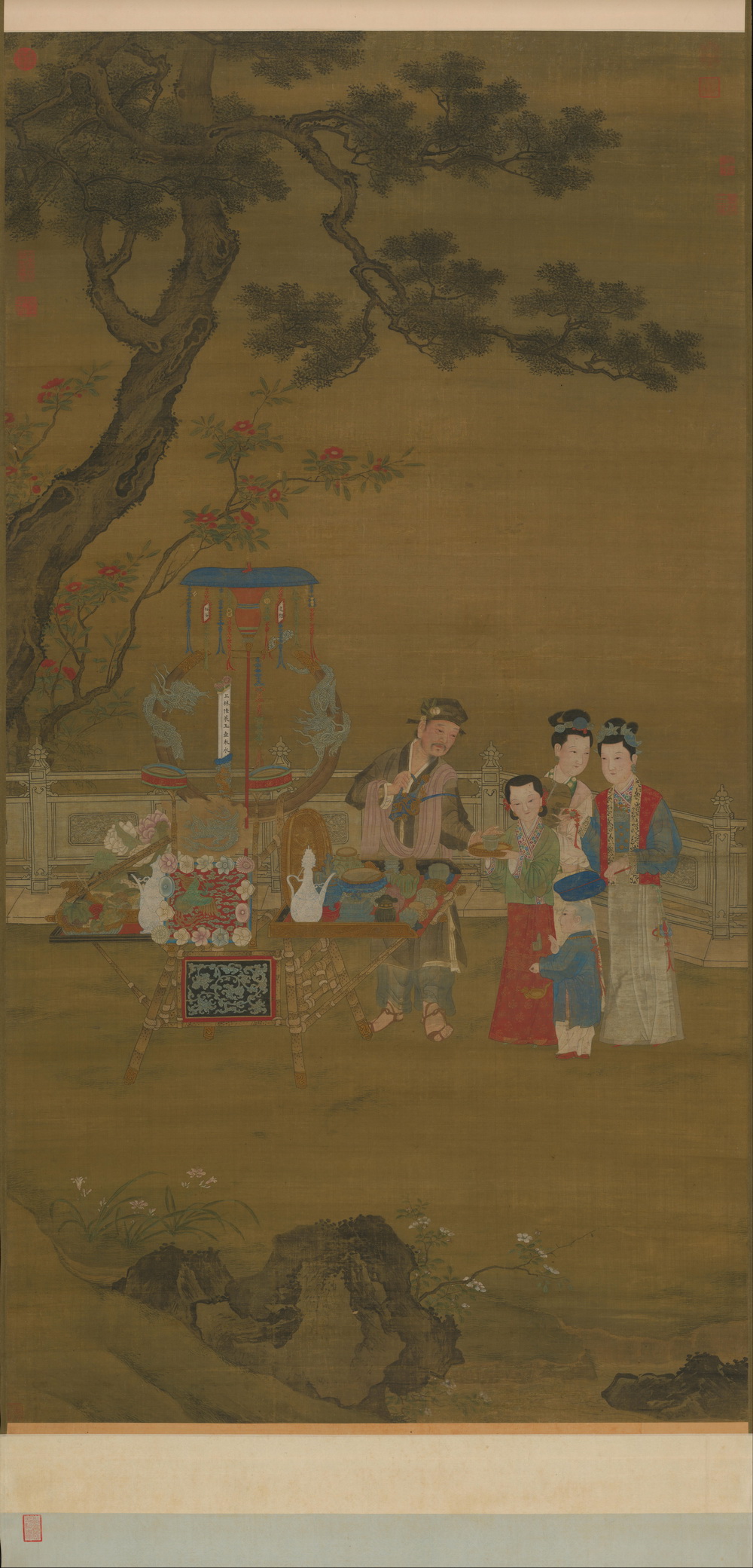 Lixia Yi Hou "The Grasshopper Sings": All things are beautiful
Lixia Yi Hou "The Grasshopper Sings": All things are beautiful
The phenology of Lixia is, first, the sing of the grasshopper, secondly, the emergence of earthworms, and thirdly, the birth of king melons. That is to say, in this solar term, you can first hear the chirping of grasshoppers in the field, and then you can see earthworms digging soil on the ground, and then the vines of the king gourd start to climb and grow rapidly. Field animals and plants also show the importance of the beginning of summer in agriculture.
Beginning in the beginning of summer, entering the first hour of the three waiting days of the beginning of summer - "Ming of the Grasshopper". Zhu Youzeng wrote in his revision of "Book of Yizhou·Sixun": "The grasshopper is the genus of frogs. The frog calls start in February. Those who call at the beginning of summer are small in size, and their color is brown and black, and they like to gather in shallow water. And it sings." And "The Collection of the Seventy-two Hours of the Moon Order" said: "The grasshopper, the small insect, grows out of the soil at night, and today people call it a soil dog, a mole cricket and a stone rat. , a crab, and the dialect varies from place to place."
Xu Lijing, the author of "The Twenty-Four Solar Terms and Seventy-Two Hours", believes that no matter whether the grasshopper is a frog or a worm, it is a kind of burrowing animal with heavy Yin Qi. When the beginning of summer comes, it also begins to run out of the hole and become active beside the rice fields. , By the pond, you can not only eat the small creatures in the water, but also enjoy the shade under the rice and grass, you can also raise your head to swallow the insects flying in the field, and sing contentedly when you are full. Even the humble little grasshopper lives so freely and comfortably, which shows how suitable the beginning of summer is for the growth of all things. "
Lixia is usually in the fourth month of the lunar calendar (today is the fifth day of the fourth lunar month), which is an extremely important solar term, so it is called the "April Festival", which is like the interpretation of "The Seventy-two Hours of the Moon": "Lixia, four Moon Festival. The vertical character interpretation sees spring. Summer is false. Everything is false at this time." It is said that all things begin to grow in an enthusiastic mode.
"On the day of Mengxia, heaven and earth began to communicate, and all things were beautiful." At this time, the summer crops are in the late stage of growth, the winter wheat is blooming, the rapeseed is close to maturity, and the year of the summer crops is basically finalized. The management of rice planting and other spring-sown crops has also entered a busy season. Therefore, the farming society attaches great importance to the Lixia solar term. In the Zhou Dynasty, on the day of the beginning of summer, the emperor personally led civil and military officials to the suburbs to "welcome the summer", and ordered Situ and other officials to go to various places to encourage farmers to work hard.
Looking at the Summer Season from the Book of "Moon Orders"
Ancient China, both official and private, attached great importance to the dissemination of time series and seasons, especially the records of the sun, moon and stars, weather and temperature, changes in animals and plants according to the order of the twelve months of the lunar calendar, and the arrangement of production and festival activities according to phenological changes. The monthly order has the most far-reaching impact.
The earliest document that recorded the order of the month may be "Xia Xiaozheng", which was written in the Spring and Autumn Period and recorded the calendar of the Xia Dynasty. There are many existing ancient artworks that involve the depiction of the seasons of a single season, such as the "Sui Dynasty" on New Year's Day. "Picture", "Three Sheep Kaitai", Lichun's "Spring Ox Picture", etc. Although these pictures are closely related to the lunar calendar, there are not many lunar pictures that truly and completely depict the December festivals. The most widely circulated pictures of lunar orders mainly come from the Ming and Qing dynasties. The famous Wu Bin's "Suihua Jisheng" and the Qing court court's "Crescent Orders" currently in the collection of the National Palace Museum in Taipei. Usually there are twelve pictures in a set, focusing on depicting the typical seasonal customs of each month.
The "Yue Ling Tu" in the Qing court version is delicate and realistic. Due to the arrival of Western missionaries in China during the Kang, Yong, and Qian dynasties, the concave-convex shading and perspective relationship in Western painting methods also penetrated into Qing Dynasty paintings.
In the April volume of the Qing court version of "The Order of the Moon", it depicts the scene of trees growing and flowers blooming. At the beginning of summer, the "late spring" in the north is also green, fat, red and thin. Only the artificially cultivated peonies are still in bloom, and the roses are accumulating. The clusters of peony flowers depicted in the fourth volume of "The Order of the Moon" are realistic, while the magnolia tree with white flowers is a re-creation of the painter's fill in the picture. By the end of the fourth month of the lunar calendar, only lush greenery remains.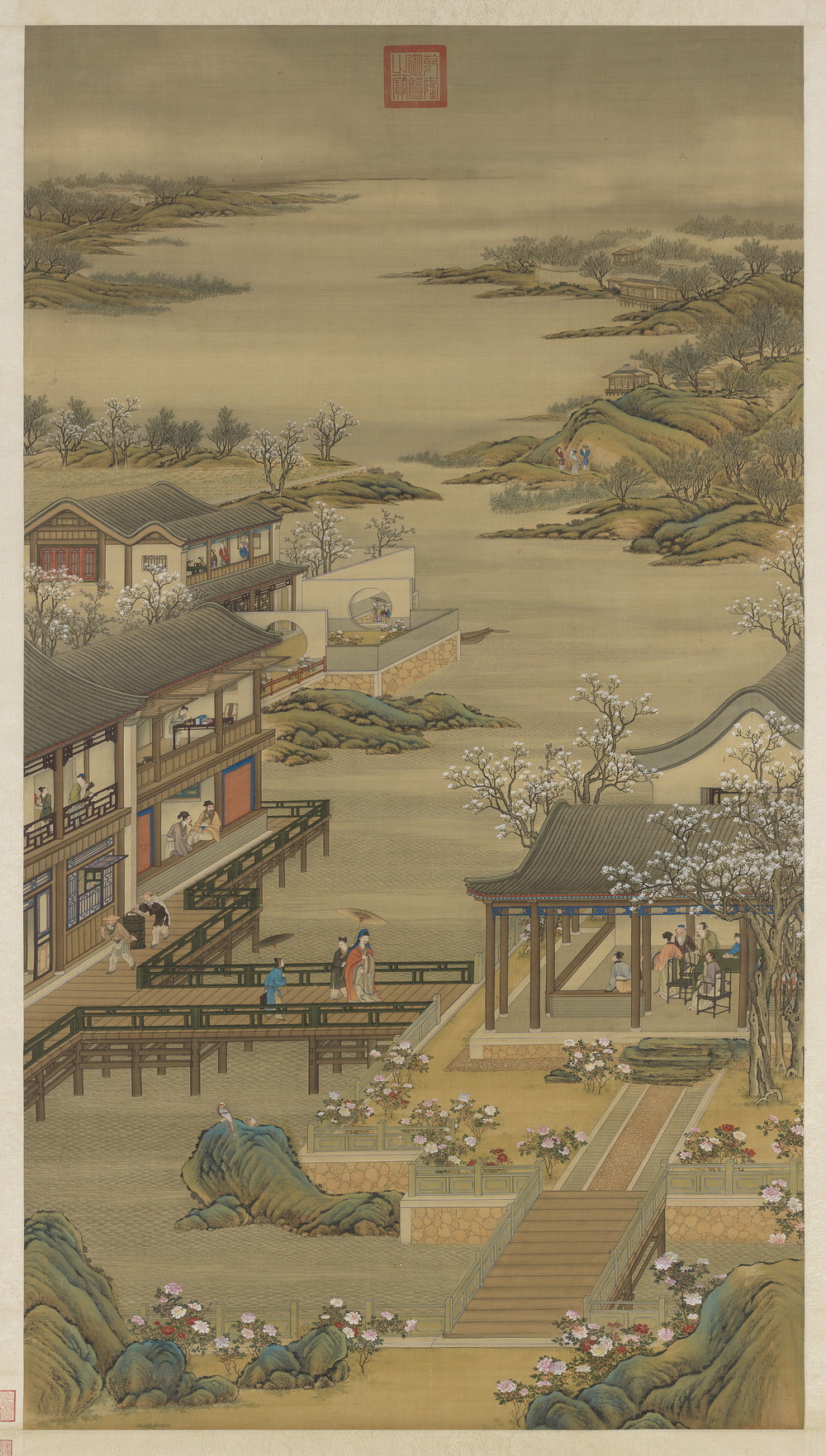
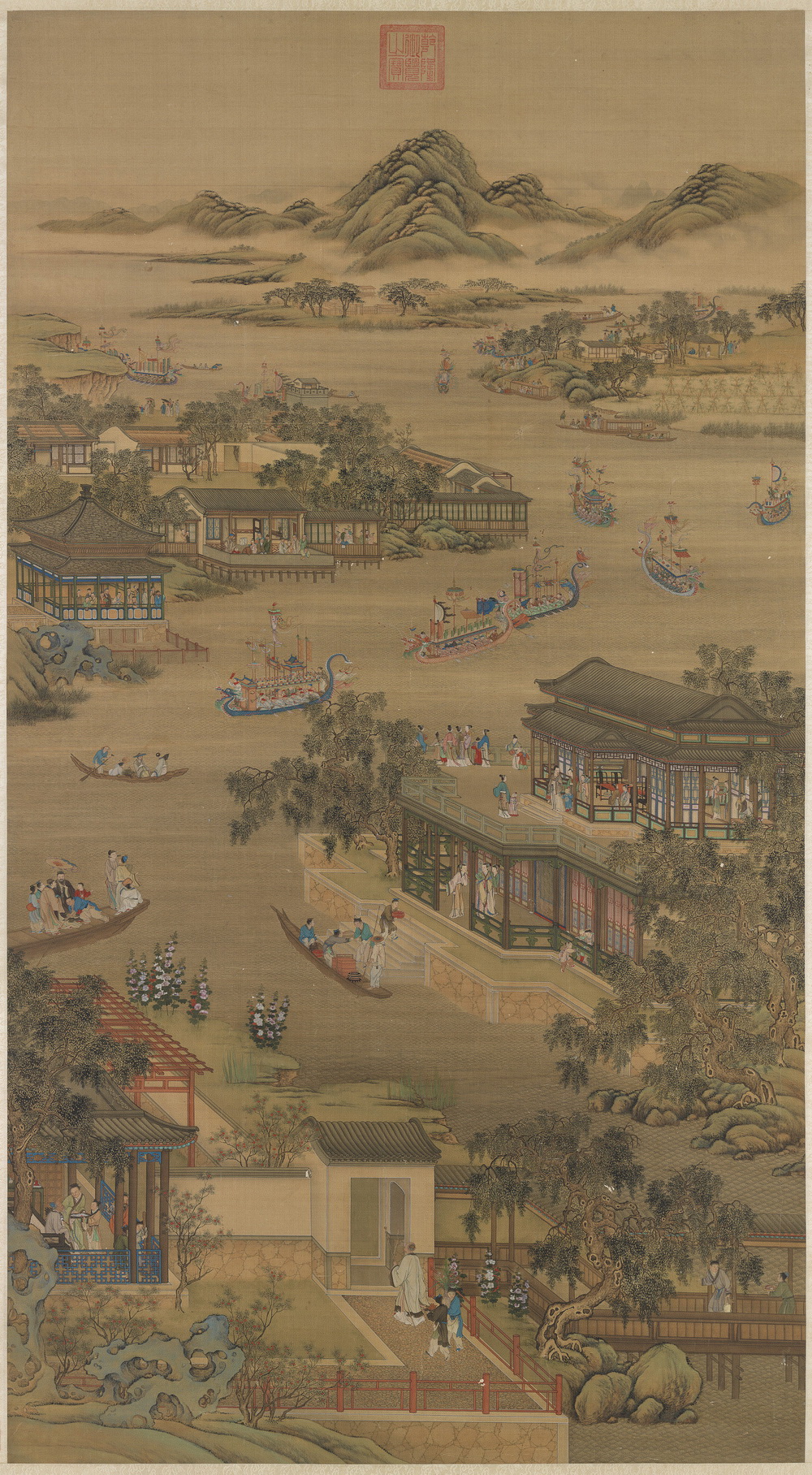
For example, judging from the season of "Lixia", the book "Lixia Yiwaiting of the Grasshopper Singing" is written as: "The grasshopper is not one thing, there are two: the name of the worm and the name of the frog. The two things are obvious. Cai Shiyun : Mole, Mole Cricket; Grasshopper, Shrimp and Toad, that is, it is now feeding frogs. It is the moon, and the yin qi begins to move below, so it sings in response." Through the identification and examination of animals that chirping in the summer season, click characterize the phenology. In the picture below, we select the representation of the second and third princes of Lixia in the Ming Dynasty "Yue Lingtu", so that the viewer can get a glimpse of it.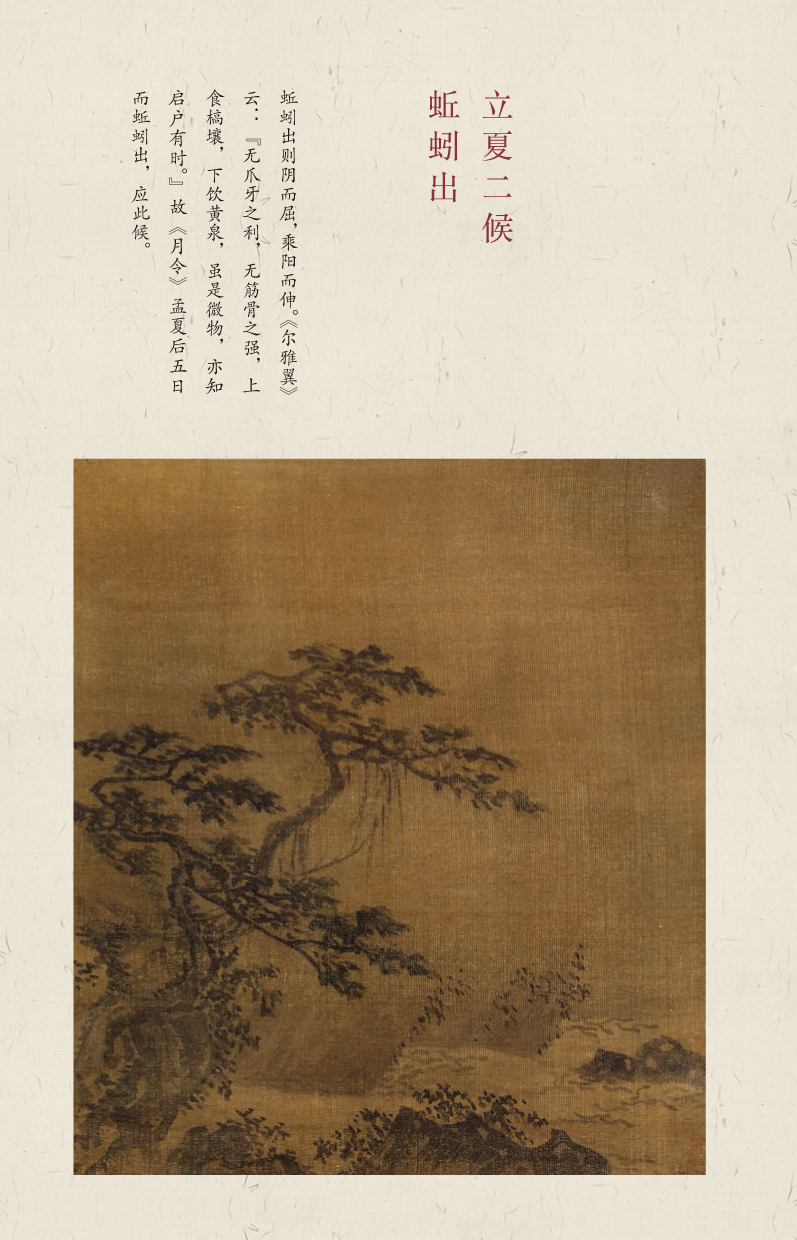

This year, May 5th is the beginning of summer, but the astronomical time, the biological time of the earth, and the humanistic time are not strictly consistent. The Chinese often have three months of June, July and August as summer. In climatology, the Chinese scholar Zhang Baokun combined phenological phenomena with agricultural production, and in 1934 put forward the seasonal method of climatology. The climatic (five-day) average temperature decreases steadily to below 10°C as the start of winter, and steadily rises to above 22°C as the start of summer; when the climatic average temperature steadily rises from below 10°C to 10°C, the start of spring; the climatic average temperature starts from 22 When the temperature above ℃ falls steadily to below 22 ℃, it is regarded as the beginning of autumn.
During the beginning of summer, the temperature difference between the north and the south of our country is quite large. Whether it is the beginning of spring or the beginning of summer, the word "Li" may be a kind of hesitation and wandering. Not all the same. This spring is early and the weather is hot. Several torrential rains with a scorching summer atmosphere have already fallen in the south, and the temperature in many areas in the north has once risen to 30 degrees, and it actually feels a bit "scorching hot".
 Lixia special offering: peony, peony
Lixia special offering: peony, peonyAt the beginning of summer, plum blossoms, magnolias, cherry blossoms, peach blossoms, plum blossoms, lilacs, and begonias have disappeared. The huge flowers of the towering paulownia trees in the north have fallen heavily. The golden and silver honeysuckle is very interesting because of its white-to-yellow flowers. Favored for its dark fragrance, the roses that are suitable for growing in the north begin to charge, and they will bloom brilliantly throughout the summer, making every ordinary street in the north a dream.

Honeysuckle
There are also peony and peony that belong to the turn of spring and summer. Because of the beautiful and large flower shape, peony has become a "special offering in early summer". All flower shops on the street use large buckets to fill peony buds. This flower does not bloom for a long time. It will bloom vigorously soon after it wakes up. withered quickly. As a woody plant, peony has long been considered proud because of its widely-publicized story of being banished to Luoyang. The pride of peony is probably also reflected in the fact that it is broken and placed in a vase, and will soon die magnificently. , its breathtakingly gigantic flowers wilt quickly.Of course, there are also some new varieties of flowers that attract attention every year. This year's oil painting peony and butterfly peony are the hottest flowers. The flowers of these two kinds of flowers have metallic luster. Oil painting peony, also known as "white phoenix" and "oil peony", is a common single-petal peony variety, which was originally a commercial crop for oil extraction. When it is opened, it is as big as a palm, and its petals are irregularly curled. It has an ancient rhyme of Tang style and has a unique style. It is inevitable that people will lament that it is opened alone and then sent to extract oil. It will inevitably burn the qin and cook the crane.

oil painting peony
The terroir of Shandong is suitable for the growth of peonies. Several large cities and counties rich in peonies, such as Heze (ancient Caozhou), have many varieties of peonies. This also gave Pu Songling, a native of Shandong, abundant creative inspiration. In his "Strange Tales from a Liaozhai", the figure of peony is frequently seen, and the two articles "Xiangyu" and "Gejin" are twists and turns and full of tragic implications. The beauty of peony flowers is always coveted, and peony's love for the homeland is also its nature. For example, in "Xiangyu", the separation between the scholar and Xiangyu begins with "there is the Jimo Lan family, who enters the palace and looks around, sees white peony, delights it, and digs and moves to the path. After a few days, I heard the Lan family moving flowers to their home. , the sun will wilt." The scholar wanted to save Xiangyu, "seeking to transplant his family", but Xiangyu said from himself: "The concubine is weak and can't be rehabilitated. And each creature has its own place, and the concubine is not intended to be born. Jun's family, if you violate it, you will promote longevity."Celebrating Spring and Beginning of Summer: A Summer of Cultural Significance
Entering into the discussion of the cultural meaning of "Xia", "Xia" means "great and powerful" in both Qiang and Tibetan languages.
The Chinese people in the Spring and Autumn Period said: "Xia is a big country. Therefore, a big country is called Xia." "Shuowen": "Xia is a Chinese person." become the name of a country and culture. China has the greatness of etiquette, so it is called Xia; it has the beauty of clothing and regulations, it is called Hua. Xia has many other names. In "Er Ya", Xia is "Zhu Ming", "Chang Ying", "Nine Summer", "Haotian" and so on. "Han Book of Rites and Music" says: "Zhu Ming is prosperous, and he applies it to all things."
Yu Shicun talked about: The big house is also called Xia, and the tall buildings are the summer house: "I didn't know that Xia was Qiu Xi, but the two east gates could be ruined?" In ancient China, Dashui was also called Xia; Hanshui was once called Xia Shui, Hankou is called Xiakou. Qu Yuan's poem: "Go to your hometown and go far away, follow Jiangxia to exile."
In "The Book of Time", Yu Shicun wrote: The ancestors also had a feeling of cherishing the spring when the beginning of summer came, so they would prepare wine and food for the joy of the beginning of summer, as if they were sending people away. Wu Ou Ting's poem "Lixia" said: "There is no choice but to let the spring go, and let the cherry and bamboo shoots return in the spring."
Beginning of summer to taste new and early adopters is also the right meaning. Broad beans, amaranth, and cucumbers are the "three fresh things in the ground"; cherries, loquats, and apricots are the "three fresh things in trees"; There are also "Lixia eats plum, can make the color beautiful", Lixia eats mulberries, cherries and other food customs. In the Suzhou area, there is a saying that "Lixia sees three new things", and the three new ones are cherries, green plums and wheat, which are used to worship ancestors. There are also eating "Lixia rice", "Lixia dog", "Lixia egg", drinking "Lixia tea", etc., such as "Lixia porridge": "A bowl of Lixia porridge will never worry about life. Lixia also has the custom of weighing. People hang a large wooden scale at the entrance of the village or in the gate of the platform, and a stool is hung from the hook of the scale. Everyone sits on the stool in turn and weighs. The person who weighs the scales speaks auspicious words while weighing the scales. Eighty-seven, live to ninety-one". Cai Yun has a poem: "The wind opens the embroidered pavilion and raises the clothes, but it is not a swing show. In order to hang the weight, the official scale was used to evaluate Yanshou and Huanfei. "
There is a poem by Yang Wanli of Song Dynasty: "The emperor's city stopped at noon on June, and the city people were like cooking and sweating like rain. The sound of selling ice came across the water, but pedestrians did not eat it." The "lingering person" is specialized in cutting ice, hiding ice, and using ice. "Yanjing Sui Sui Ji" records: "The four best ice foods at that time, one was sour plum soup, the other was watermelon juice, the third was almond tofu, and the fourth was assorted plates, all of which were iced."
The Ming Dynasty painting "Xia Jing Huo Lang Tu" depicts the scene of drinking summer drinks. The back garden of the palace hall is carved with jade, and a cold drink doctor in disguise is pouring ice water drinks for a young monk. From the dragon carving on the teapot, it can be seen that this is not an ordinary family, or that the imperial painter of the Ming Dynasty painted the emperor's royal face to match a certain scene, like today's "role-playing", the emperor, the concubine, the princess, the little prince All are actors.
 Lixia Yi Hou "The Grasshopper Sings": All things are beautiful
Lixia Yi Hou "The Grasshopper Sings": All things are beautifulThe phenology of Lixia is, first, the sing of the grasshopper, secondly, the emergence of earthworms, and thirdly, the birth of king melons. That is to say, in this solar term, you can first hear the chirping of grasshoppers in the field, and then you can see earthworms digging soil on the ground, and then the vines of the king gourd start to climb and grow rapidly. Field animals and plants also show the importance of the beginning of summer in agriculture.
Beginning in the beginning of summer, entering the first hour of the three waiting days of the beginning of summer - "Ming of the Grasshopper". Zhu Youzeng wrote in his revision of "Book of Yizhou·Sixun": "The grasshopper is the genus of frogs. The frog calls start in February. Those who call at the beginning of summer are small in size, and their color is brown and black, and they like to gather in shallow water. And it sings." And "The Collection of the Seventy-two Hours of the Moon Order" said: "The grasshopper, the small insect, grows out of the soil at night, and today people call it a soil dog, a mole cricket and a stone rat. , a crab, and the dialect varies from place to place."
Xu Lijing, the author of "The Twenty-Four Solar Terms and Seventy-Two Hours", believes that no matter whether the grasshopper is a frog or a worm, it is a kind of burrowing animal with heavy Yin Qi. When the beginning of summer comes, it also begins to run out of the hole and become active beside the rice fields. , By the pond, you can not only eat the small creatures in the water, but also enjoy the shade under the rice and grass, you can also raise your head to swallow the insects flying in the field, and sing contentedly when you are full. Even the humble little grasshopper lives so freely and comfortably, which shows how suitable the beginning of summer is for the growth of all things. "
Lixia is usually in the fourth month of the lunar calendar (today is the fifth day of the fourth lunar month), which is an extremely important solar term, so it is called the "April Festival", which is like the interpretation of "The Seventy-two Hours of the Moon": "Lixia, four Moon Festival. The vertical character interpretation sees spring. Summer is false. Everything is false at this time." It is said that all things begin to grow in an enthusiastic mode.
"On the day of Mengxia, heaven and earth began to communicate, and all things were beautiful." At this time, the summer crops are in the late stage of growth, the winter wheat is blooming, the rapeseed is close to maturity, and the year of the summer crops is basically finalized. The management of rice planting and other spring-sown crops has also entered a busy season. Therefore, the farming society attaches great importance to the Lixia solar term. In the Zhou Dynasty, on the day of the beginning of summer, the emperor personally led civil and military officials to the suburbs to "welcome the summer", and ordered Situ and other officials to go to various places to encourage farmers to work hard.
Looking at the Summer Season from the Book of "Moon Orders"
Ancient China, both official and private, attached great importance to the dissemination of time series and seasons, especially the records of the sun, moon and stars, weather and temperature, changes in animals and plants according to the order of the twelve months of the lunar calendar, and the arrangement of production and festival activities according to phenological changes. The monthly order has the most far-reaching impact.
The earliest document that recorded the order of the month may be "Xia Xiaozheng", which was written in the Spring and Autumn Period and recorded the calendar of the Xia Dynasty. There are many existing ancient artworks that involve the depiction of the seasons of a single season, such as the "Sui Dynasty" on New Year's Day. "Picture", "Three Sheep Kaitai", Lichun's "Spring Ox Picture", etc. Although these pictures are closely related to the lunar calendar, there are not many lunar pictures that truly and completely depict the December festivals. The most widely circulated pictures of lunar orders mainly come from the Ming and Qing dynasties. The famous Wu Bin's "Suihua Jisheng" and the Qing court court's "Crescent Orders" currently in the collection of the National Palace Museum in Taipei. Usually there are twelve pictures in a set, focusing on depicting the typical seasonal customs of each month.
The "Yue Ling Tu" in the Qing court version is delicate and realistic. Due to the arrival of Western missionaries in China during the Kang, Yong, and Qian dynasties, the concave-convex shading and perspective relationship in Western painting methods also penetrated into Qing Dynasty paintings.
In the April volume of the Qing court version of "The Order of the Moon", it depicts the scene of trees growing and flowers blooming. At the beginning of summer, the "late spring" in the north is also green, fat, red and thin. Only the artificially cultivated peonies are still in bloom, and the roses are accumulating. The clusters of peony flowers depicted in the fourth volume of "The Order of the Moon" are realistic, while the magnolia tree with white flowers is a re-creation of the painter's fill in the picture. By the end of the fourth month of the lunar calendar, only lush greenery remains.

The April Axis of the Drawing of the December Order by the Art Academy
The fifth month of the lunar calendar is also known as Midsummer. In the old days, farmers used calamus leaves and mugwort leaves to hang at the head of the door to exorcise evil spirits, because the month of May was called Puyue. "Erya·Shutian" says: "May is Gao." Hao Yixing explained it as, "The Gao is the same as the high. The high is on the top, and in the fifth month, the yin is born, if you want to go up, and everything is solid. ." Therefore, May is also known as the Satsuki. The May volume of "Yue Lingtu" describes the folk activities of dragon boat racing. In the painter's pen, thousands of birds fly in unison, and the intense and enthusiastic competition attracts people from both sides of the strait to watch.
The May Axis of the Drawing of the December Order by the Art Academy
The painting of the Ming Dynasty's "Yue Ling Tu" in the Palace Museum is more elegant and upright, with flowers, plants and trees dyed with ink dots.For example, judging from the season of "Lixia", the book "Lixia Yiwaiting of the Grasshopper Singing" is written as: "The grasshopper is not one thing, there are two: the name of the worm and the name of the frog. The two things are obvious. Cai Shiyun : Mole, Mole Cricket; Grasshopper, Shrimp and Toad, that is, it is now feeding frogs. It is the moon, and the yin qi begins to move below, so it sings in response." Through the identification and examination of animals that chirping in the summer season, click characterize the phenology. In the picture below, we select the representation of the second and third princes of Lixia in the Ming Dynasty "Yue Lingtu", so that the viewer can get a glimpse of it.


Ming Dynasty album "Moon Order Map"
Related Posts